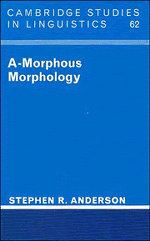Book contents
- Frontmatter
- Contents
- Acknowledgments
- Introduction
- 1 The study of word structure
- 2 Why have a morphology at all?
- 3 Is morphology really about morphemes?
- 4 The interaction of morphology and syntax
- 5 The theory of inflection
- 6 Some complex inflectional systems
- 7 Morphology in the lexicon: derivation
- 8 Clitics are phrasal affixes
- 9 The relation of morphology to phonology
- 10 How much structure do words have?
- 11 Composites: words with internal structure
- 12 Morphology and the typology of languages
- 13 Morphological change
- 14 Morphology as a computational problem
- References
- Index
8 - Clitics are phrasal affixes
Published online by Cambridge University Press: 10 January 2011
- Frontmatter
- Contents
- Acknowledgments
- Introduction
- 1 The study of word structure
- 2 Why have a morphology at all?
- 3 Is morphology really about morphemes?
- 4 The interaction of morphology and syntax
- 5 The theory of inflection
- 6 Some complex inflectional systems
- 7 Morphology in the lexicon: derivation
- 8 Clitics are phrasal affixes
- 9 The relation of morphology to phonology
- 10 How much structure do words have?
- 11 Composites: words with internal structure
- 12 Morphology and the typology of languages
- 13 Morphological change
- 14 Morphology as a computational problem
- References
- Index
Summary
Now that we have outlined proposals for the treatment of inflectional and derivational morphology, we return to another problem which has already come up several times in previous chapters: the analysis of clitics. Clitics constitute the clearest prima facie challenge to the identification of phonological and syntactic notions of the word, since it is obvious that they represent the co-presence within a single phonological unit of two (or more) syntactically independent elements. The study of clitics has traditionally focused precisely on this apparently problematic aspect of their nature, assuming that clitics involve the association of distinctive syntactic properties with some phonological characterization.
We will suggest here, however, that this is not the right way to view the phenomena associated with ‘clitics’ in the languages of the world. It does indeed appear that there is a phonological characteristic associated with the root sense of ‘clitic,’ to wit, the property of being prosodically dependent on adjacent material. When we ask about the supposedly distinctive syntactic properties associated with clitic-hood, however, it will become clear that (a) not all phonological clitics have any syntactic properties distinct from those of corresponding non-clitics within a given language; (b) in at least some cases, the syntactic peculiarities of ‘clitics’ are found in the absence of the prosodic dependence which otherwise characterizes this class; and (c) the unusual distribution and placement of ‘clitics’ do not reflect the operation of unusual rules of syntax (in the usual sense), but rather represent a generalization of the rules of word-level morphology.
- Type
- Chapter
- Information
- A-Morphous Morphology , pp. 198 - 223Publisher: Cambridge University PressPrint publication year: 1992



